take the cushion cloth off reglue or rerubber if the rubber is ready , it is acceptable to also put a small staple in the lower edge of the rubber undercutt to avoid it falling off the block , the only part of the rubber not supported by a good rebate shelf is at the pocket openings , on some older tables the manufacturers have rebated a little on the pocket openings , this helps keep the rubber in place .
at the openings a little cloth has to be put behind the rubber so you do have to remove the rubber along the top edge a little to complete the back tuck of the cloth .
On steel blocks this is differ's to normal cushions and the cloth is formed around the end block rather than behind the top edge of rubber at the pocket openings .
it is possible if carefull to just remove a little of the cloth on the openings and reglue the rubber back on , but this can be very difficult to do for the none experienced .
Geoff
Announcement
Collapse
No announcement yet.
Table maintenance
Collapse
X
-
time to revive this thread with a maintenance question...
What's the procedure for fixing the problem of the rubber dropping around the pocket entry?
Leave a comment:
-
BTW to prove I can do helpful posts I can't afford a proper iron. SO I have an old ordinary iron. The thermostat is inoperative but it is stuck in the on position. So I do more or less what Geoff suggests. I put it on for a while, test it on some cloth to see if it is ok. If it doesn't scorch I just test the cloth with the back of my hand- I know how hot it should feel. If OK I just then crack on with ironing. If it needs to eb a bit warmer I give it another few seconds. I had never thougt about alternating the side of the table on which I start but shall do so from no on.
Leave a comment:
-
Always better to try with the iron a bit too cool. That way you have no problem. Too hot once and you have a problem!
Also remember, guys, don't EVER let wife/gf see you ironing the table. If she ever gets the idea you can iron stuff....... well just don't do it!
Leave a comment:
-
yes over heating of the iron especialy if it has no thermostat will cause serious cloth burn and yes can cause balls to run very fast and if lines are pressed in they will follow it like a tram , if no thermostat I recomend to try the iron on a piece of newspaper or better still some old second hand cloth wrapped around the brush , if it scorches this do not attempt to iron the table , the sole plate will require cleaning with emery and wet and dry until all the burnt residue is removed then give it a good polish up until dry , do not let the plate rust by sitting damp after cleaning the sole plate .
Now what type of cloth have you got fitted to the table , Hainsworth or Strachan ?
Hainsworth cloths have a 10% man made fibre content and is more prone to burning than Strachan which is 100% pure new wool .
I have seen the sole plate of irons that are used on no9 setting on a thermostat iron with burnt on cloth from Hainsworth cloths , you have to set the thermostat a little lower on Hainsworth cloths say no 7 or 8 on the thermostat .
Chinese irons have a will of their own sometimes they can overheat and cause burning I have had one even melt its own plug into its socket , Dowsing irons are the best to use , and unless you are experienced with an iron that has no thermostat then try this trick , get a plug in timer that controls the iron , set it for 10 mins , when it switches the iron off it is ready , if you think it could do with a little more heat set it for 11 mins and so on until you get the ideal heat setting you require .
Note allways heat a none thermostat iron from cold when useing the timer method . never reheat useing the 10 min timer trick as you will not get the same heat setting ...IT WILL BE HOTTER
A Dowsing thermostat iron should never be left on un attended just because it has a thermostat and you think ah well it can't over heat , the thermostat will be over worked and the result is burn out of the stat and sometimes it takes the heating element with it , repairs by dowsings will inccur a charge of over £100 with postage charges just to repair it , we had a club who kept burning out the thermostats and I found out why , the girl who served behind the counter used to brush and iron the tables , but if customers came in and she went behind the counter to serve , she left the iron on all Day , which of course just overworked the thermostat and burnt it out , i think that club went through around 6 irons before I twigged what was happening . BUT they still burn irons out on a regular basis .
a freshly heated iron is at it's hottest when first put on the table , for this reason do not hang about , start on one side of the table going down the lenth and work youre way to the middle , then go to the other side , start at the middle going down the lenth and work youre way towards the side cushion allways overlapping the lenth you have ironed before ...NEXT time you iron the table alternate the side you started from because if you keep going to the same side all the time with the freshley hot iron , you will iron that side a little hotter then the other so always alternate the side you start from ...Or simply double iron by putting the iron back on and when hot again start at the other side .
GeoffLast edited by Geoff Large; 30 January 2012, 09:30 PM.
Leave a comment:
-
I could read through all this, which I will in time when not tired, however, here's few questions...
I think I pretty much know the answer to this first one but want to see what folk have to say.
Does burning/scorching the table affect the run of the table? (Like cause the ball to deviate etc?) I say this because to be honest, our table has been scorched to death, you can clearly see lines all the way down the table, especially along each side where the ironnig has been started abd the table has what looks like a greasy sheen to it, add to that, I looked at the bottom of the iron and it's almost black due to the burn from being used when too hot!
Leave a comment:
-
I'd certainly agree with that... Amen!Originally Posted by Geoff Large View Post...What I will say is if a cloth gets that bad on cushons or Bed cloth than it's time for a recover anyway .
..after all the labour time and effort of fitting a stretched bed cloth is the same as fitting a new one so the little extra in materials is worth it in my opinion .
Leave a comment:
-
I have over the years through trial and error , looked at the posibilty of the balls jumping as it hits whats been described as the trough wear , which is a the impact mark of the ball as it hits the cushion also described as a tracking mark , even after stretching, the ball still jumps on worn cloth cushions , Degreasing can help stop balls jumping also replaceing the worn cloth on the cushions whiuch gets rid of the shiny worn in surface without any nap left .
although I cannot say a Ball will jump up after arriveing at the point of impact due to worn bed cloth trough/track mark , it may be a combination of all three , grease build up , shiny no nap cloth and the trough , also Rubber distortion after age is another factor
the trough or tracking mark is caused by the rubber being slightly higher than the centre of the Ball giving equal force down as well as away force on impact with the nose of the rubber , it is the underside edge of the rubber that the Ball makes contact with not the whole face as some may think . Deeper troughing in the corner pockets are caused by two things .
1, the whole game is based upon the ball going into a pocket so the most wear will be at the pocket opening .
2, the under cutt of the pocket jaw is forcing more pressure of the balls downwards than the normal rebound of the entire cushion lenth .
both these reason equals excessive wear at the pocket fall which is why the cloth always wears very quick in these Troughs .
another reason for ball jumping off the cushion is badly fitted blocks and rubber , blocks not at correct hieght or rubber set too low or falling off the block due to badly glued on .
altough I cannot disagree that trough or Canals as you describe is not a reason for jumping balls I would say this is not the most common fault that makes a ball jump , that is down to worn cushion cloth and grease build up , What I will say is if a cloth gets that bad on cushons or Bed cloth than it's time for a recover anyway . there is nothing worse in looks than a new set of cushion cloths and a stretched worn bed cloth , the extra it costs for the bed cloth is worth it , after all the labour time and effort of fitting a stretched bed cloth is the same as fitting a new one so the little extra in materials is worth it in my opinion .Last edited by Geoff Large; 20 January 2012, 09:07 PM.
Leave a comment:
-
Gapster: Your table looks good. just about to redo my table. What type of cloth did you use?
Leave a comment:
-
Yeah, right. What a great first post..... less is more, I feel.By the same token, I like to “give back” whenever I can
Leave a comment:
-
Hi williak,
I witnessed the phenomen you described many times in play. I've seen the cue ball hugging a side cushion then follow the curvature of the middle pocket and drop. If this happens in a serious frame of snooker you'd feel cheated.
Remember all the theories propounded as to why balls sometimes "kicked"? As I understand it, modern high speed cameras have proven that balls do not roll as it would on a perfectly level surface. Apparently the tolerance that the slates were floated to still leave enough for the balls to be "hopping" minutely on it's travel. I witnessed this personally the very night it was pointed out to me. I happened to be sitting where the table's bed was almost at my eyes' level, and saw it happen again and again. I know too that the table was one of the older ones that had been reconditioned by Thurston's, and therefore had hand-floated slates.
I raised the above because old ideas and theories are debunked all the time in various ways. I didn't just put out the idea of "canals" causing balls to jump just so. It's through years of observations and pondering the problem. Mind you, I'm not saying that loose cushions or "grease" build-up aren't a cause too. I'm pretty confident of what I say and I only regret that I haven't had the opportunity to stretch a bed cloth on a table that suffers with the "jumping balls" symptoms - at least not yet!
Leave a comment:
-
Not sure about your "ball-jumping" theory, but I agree 100% with your observation on rolling a ball in (and out and in and out of) the "canal" all the way from a baulk corner to spot corner. The ball will actually bounce its way along the cushion as the "canal" grabs it whenever it tries to escape. I once saw a fellow with good speed control drop ball after ball from a baulk corrner into the same side's middle pocket on a table with deep canals (some areas were bare right to the slate.) For those who claim this is impossible, I will concede it was on a 1950s Canadian Brunswick 6x12 which had notoriously shallow slate falls in all pockets, especially the middle ones.
Leave a comment:
-
Problem of balls striking the cushion and jumping
Good day (or night) to all. I’m new here and I’ve read some of the threads with interest. In particular, inputs from Geoff Large, moglet, T. Davidson, and others here have taught me a thing or two.
By the same token, I like to “give back” whenever I can. In this case I feel a bit of reluctance because it can appear that I’m contradicting persons that are far more learned than I. However, if one were to accept that we can always learn new things, and that knowledge may even come from a baby, then we are of an open mind.
Anyway, enough jawin’ and here goes.
I read where Geoff (and I guess others in the trade) has “blamed” dirt or “grease” build-up on the cushion nose as the main reason for balls jumping when played hard against a cushion. I beg to disagree. I’m not doubting that it can be a contributory factor, but I hold that another factor is more to blame. I blame the wear of the cloth, and more specifically, the formation of a “canal” on the bed cloth that actually “outlines the cushions” all along the bed cloth. This “canal” actually traces it’s way around the curve of the pocket openings and is even more pronounced there.
When a table has been newly re-clothed, there is obviously no such “canal”. As the table get used, the cloth wears away. The greatest wear takes place whenever a ball strikes a cushion. As the ball strikes the cushion, the rubber “gives” a bit and the ball “sinks” a bit into the cushion before rebounding. This “sinking-in” and rebounding of the ball generates a great amount of friction between the ball and the bed cloth. Naturally, with the friction there comes wear as well. With the ball being made from a much harder material than the cloth, take a guess which one will wear the most?
It is this same friction between the ball and the cloth that will wear a hole in the cloth if no spots are used. In this case it is the momentary friction generated from a ball that’s at a complete standstill on it’s spot, suddenly moving as it is struck by the cue ball. That generates a lot of damaging friction. I remember Iwan Simonis (now BAB) describing the phenomena as “rubs” as it relates to the longevity of their balls. Again, the cloth will see the worst of it.
Now back to the cushions and the jumping balls. The top cushion area normally sees the worst of it, although all bed cloth areas along all the cushions will see such wear. This is especially so if billiards is played on the table a lot since the very nature of the game utilizes the top cushion more than any other. When a “canal” has developed, a ball striking the cushion will momentarily enter this “canal” and “ride” up the cushion nose rather than rebound smoothly.
Actually, that “canal” was the reason for a standing joke years ago, when some friends and I went to play some frames on a badly worn table. I told them that once the ball was lying on the bottom cushion, it was a simple matter to roll the object ball into the pocket - and I did it just to show them!
Now why don’t the balls jump even more when struck into the jaws of a pocket since the most wear is seen there? Simple - because the rubber is undercut there and it acts similar to what I’ve read about some people setting cushions fractionally higher to counter the problem. That in itself is another topic.
To counter the “ball-jumping” phenomenon, the bed cloth can be re-stretched in all directions. I recommend that the section under each rail be done one at a time. The idea is to pull the “canal” just enough below the cushion nose all around. Now this is only a simple fix, since the dust and chalk build-up on the slate will still be there. The latter is normally removed by a judicious sanding to loosen stubborn build-up whenever a complete re-clothing job is done. This brings me back to why only a section at a time should be re-stretched. If you remove the whole bed cloth, it becomes very difficult to align the cloth and pull around 3/8 to ½ an inch of cloth under the cushion nose - and that’s all you need really.
Now I can be wrong and I am always willing to learn, so if anyone has anything to add I am always open to their inputs.
Cheers to all!
Leave a comment:
-
As promised, here are some pics...
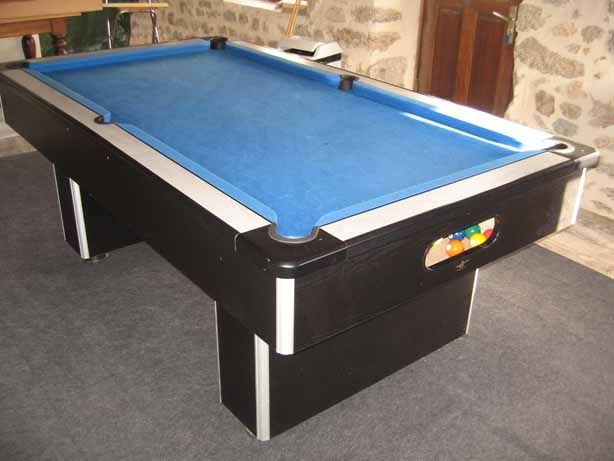
Original table
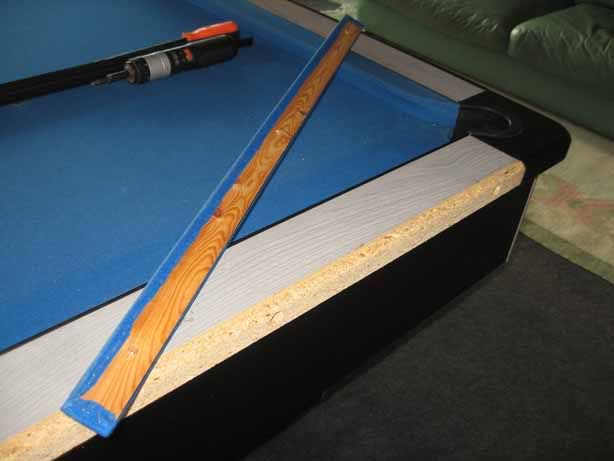
Side rails off - screws were behind the plastic side panels
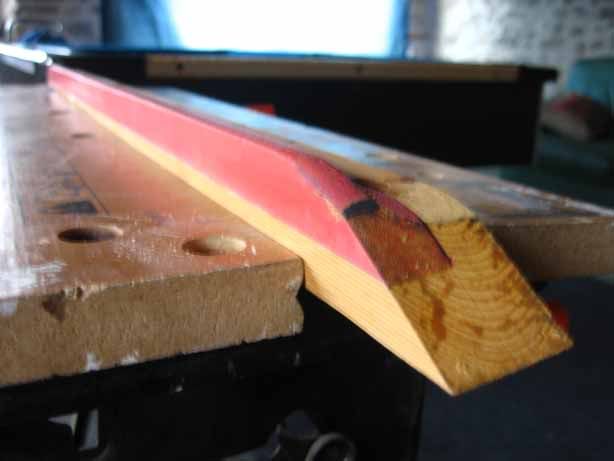
Rails ready to strip - rubber was solid and brittle.

Rails stripped and new 'cheapo' rubbers ready to fit
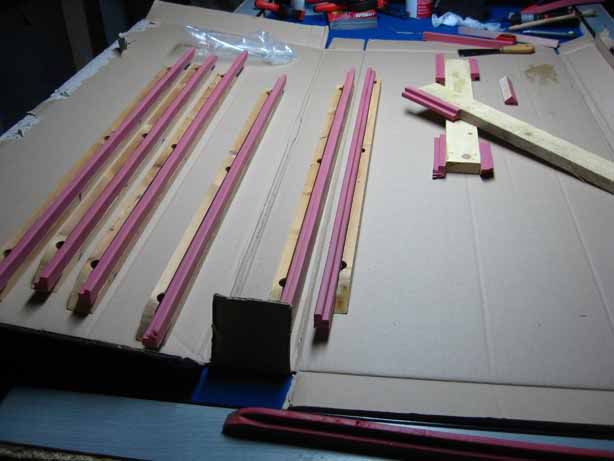
Rubbers glued on, and a few practice pieces to cut later...
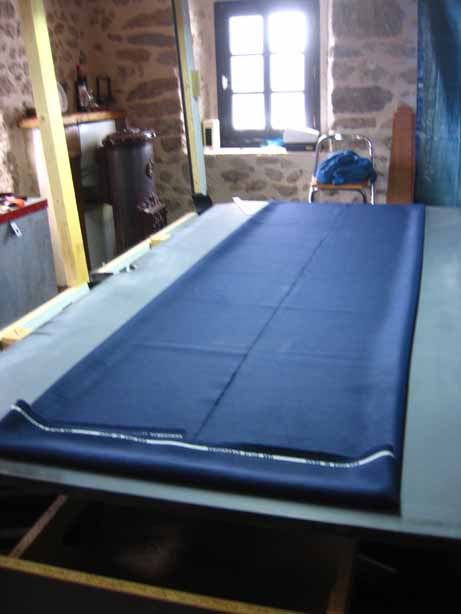
Slate cleaned and ready for new felt (Hainsworth)
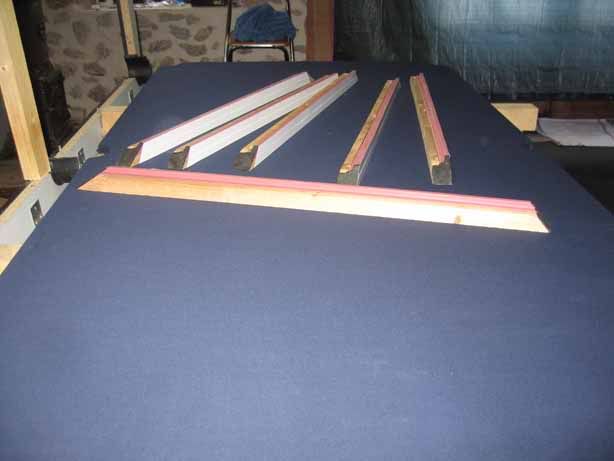
Slate bed done and rails re-rubbered - end pieces done with Tractor inner tube
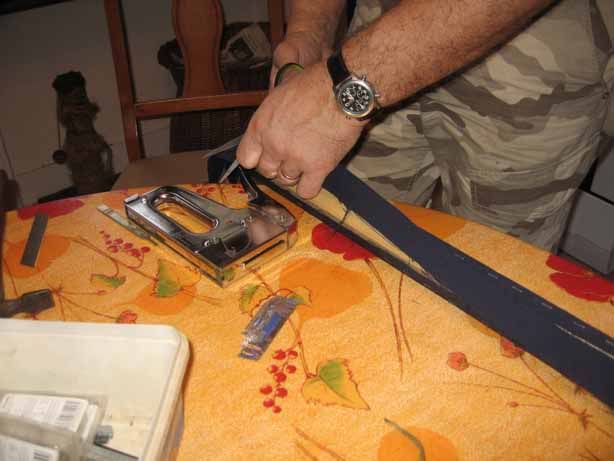
Last bit of felt trimming on the new cushion rails.
All in all it was an OK job, but the felt is not as easy at it looks to stretch properly. I would do a better job next time.
Leave a comment:
-
All finished.
The big error was in not stretching the felt enough on the slate - but it will play OK for a coupe of weeks then I'll try and re-stretch and glue later.
Cushions were a bit fiddly to felt, and I used some tractor tyre inner tube to make some cushion ends as I decided to cut the rubbers straight. All look OK, and the cushions/pockets seem to play well so no problem with changing the pocket profile.
I'm a happy bunny.
Leave a comment:
Leave a comment: